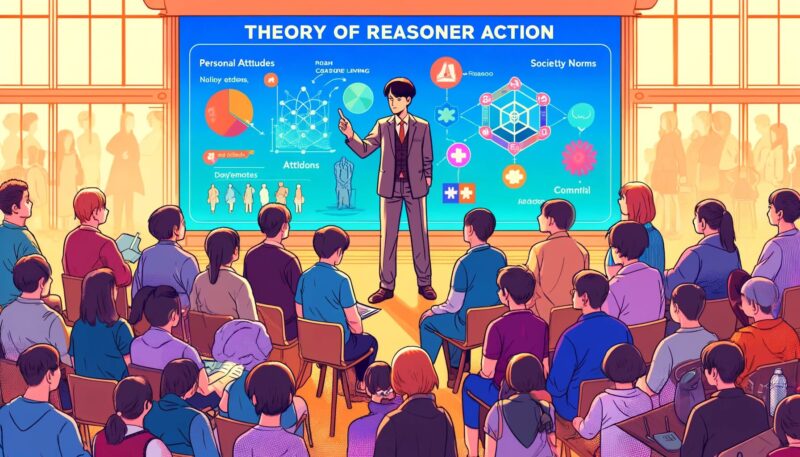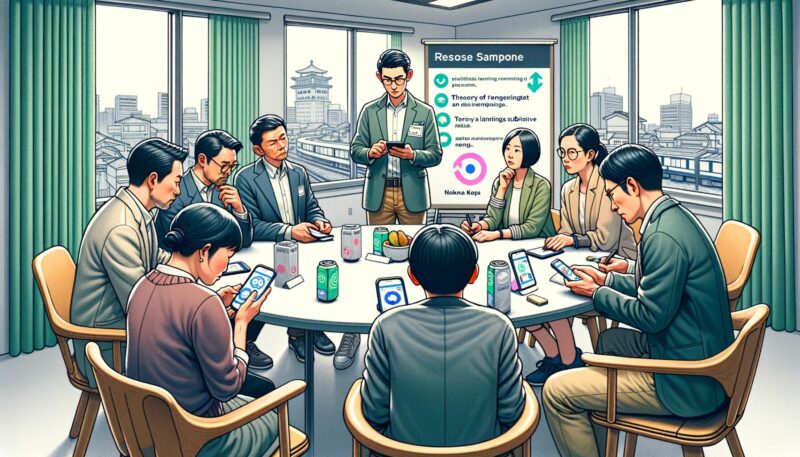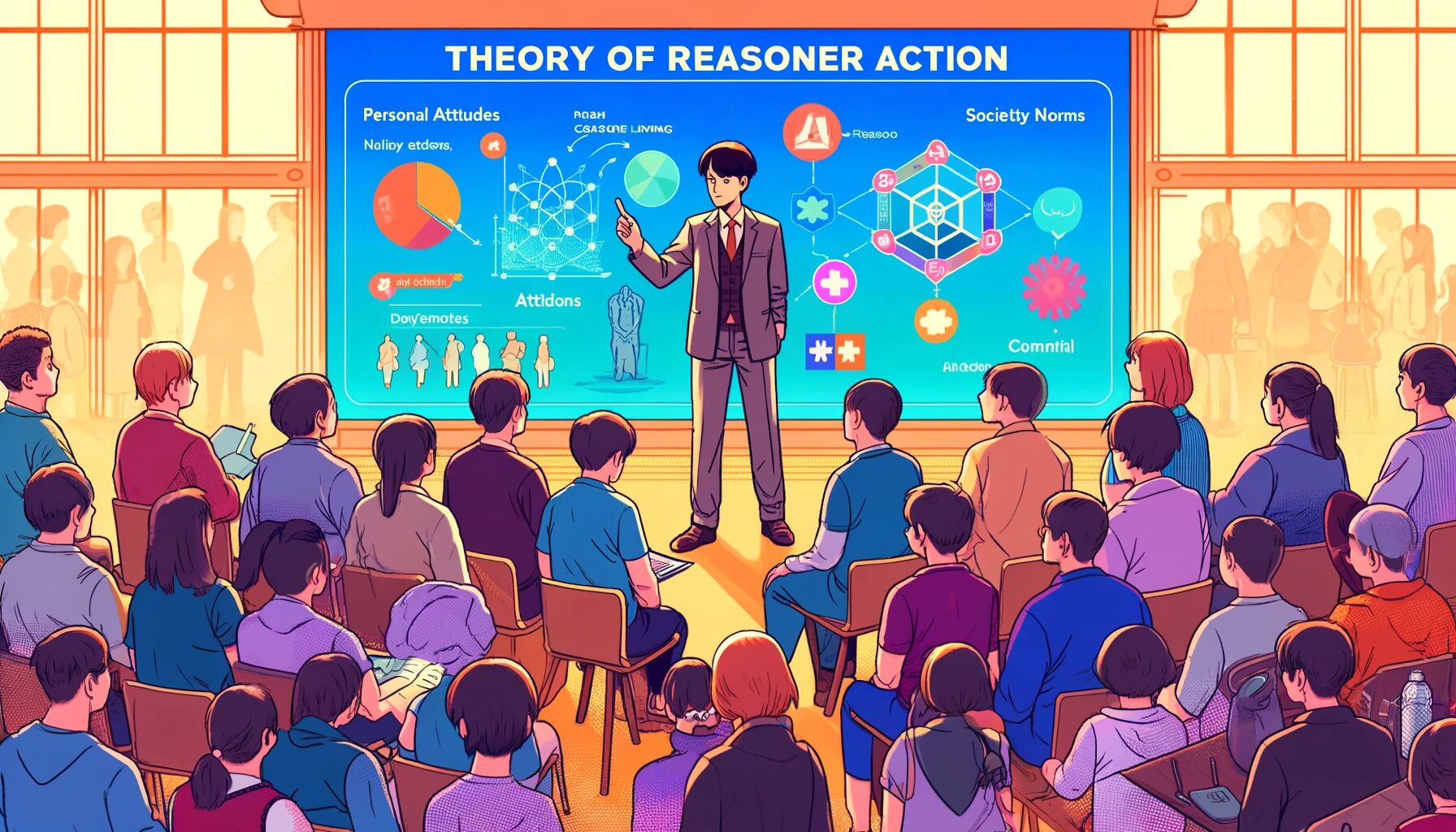理性的行動理論とは?

理性的行動理論とは、心理学で用いられる理論であり、個人があらかじめ持っている態度や行動意図に基づいて、どのように行動するかを予測するものです。
1970年代にマーティン・フィッシュバインとアイスク・アジュゼンによって開発された理性的行動理論は、個人の行動は、その行動を実行しようとする意図によって決定され、その意図自体は、その行動に対する態度やそれを取り巻く主観的規範に影響されると仮定しています。
- 行動に対する態度: その行動に対する個人的な評価(肯定的か否定的か)。
- 主観的規範: その行動をする、しないに対する社会的プレッシャー。
- 行動意図: 行動を実行するという意思決定を捉え、行動に直結する動機づけ要因。

理性的行動理論は、医療サービス、マーケティング、環境保全などさまざまな分野で広く応用されており、特定の状況において人々がなぜそのように行動するのかを理解し予測するのに役立ちます。
具体例で分かりやすく解説!
健康に対する行動の変化

賑やかな東京の街で、熱心な健康愛好家であり人気ブロガーでもあるYuya-sanは、大きな課題に直面していました。
彼は健康的なライフスタイルに取り組んでいるにもかかわらず、彼の友人やブログの読者の多くが同じような習慣を取り入れるのに苦労していることに気づきました。
この状況を変えようと意欲に駆られたYuya-sanは、彼らの行動にポジティブな影響を与えるために理性的行動理論を使うことにしました。
Yuya-sanはまず、読者の健康やフィットネスに対する考え方を理解するために、アンケートを実施しました。

彼は、多くの人が健康的な生活について好意的な見方をしている一方で、健康よりも利便性を優先しがちな多忙なスケジュールや社会環境にプレッシャーを感じていることを発見しました。
この問題に取り組むため、Yuya-sanは健康的な行動のメリットを強調するだけでなく、主観的な規範にも言及する一連のブログ記事を作成しました。
彼は、多忙な生活と健康的な習慣の両立に成功した別の人のストーリーを紹介し、社会的規範の認識を変えることに成功しました。
意識と社会的規範の両方が、より健康的なライフスタイルのためにどのように調整できるかを戦略的に示すことで、Yuya-sanは波及効果を生み出し、読者がより多くの情報を得た上で、前向きな健康上の決断をするよう促すことができました。
環境に配慮した行動の推進

京都の郊外にある小さな町で、地元の環境活動家ハルカは、新しいリサイクルの取り組みを支持するよう地域住民を説得するという難題に直面しています。
地域の人々は自然を大切にしているにもかかわらず、リサイクル率は低いです。
ハルカは理性的行動理論を使って戦略を立てることにしました。
彼女はまず、地域の会合やニュースレターを通じて、リサイクルの環境面での利点について地域住民を教育することから始めます。
彼女は、個人の行動がいかに持続可能性という大きな目標に貢献するかを強調し、積極的な意識改革を目指しました。

次にハルカは、リサイクルプログラムによって街がきれいになり、ゴミが減少した近隣の町を紹介することで、主観的規範を変えようとします。
これらの町から講演者を招き、彼らのポジティブな経験を共有することで、リサイクルに関連する社会規範に対する地域社会の認識を変えることができました。
個人的な態度の変化と、社会的なプレッシャーに対する認識を変えることで、ハルカは町のリサイクル率を上げたいと考えており、理性的行動理論が環境に関する意思決定にどのように適用できるかを実証しています。
マーケティング戦略

賑やかな大都市大阪で、マーケティング戦略家のケンジは、都市部の通勤を改善するためにデザインされた新しいスマートフォンアプリの立ち上げを任されました。
このアプリは、交通情報、公共交通機関の時刻表、ライドシェアのオプションなどを統合したものです。
ケンジは、単に機能的なアプリを作るだけでは十分ではないことを理解しています。
ケンジは理性的行動理論を用いて、態度を変え、社会規範を調整することに焦点を当てます。

彼はまず、オンライン調査を実施し、都市住民の現在の通勤に対する不満と、より良い通勤ソリューションのためにテクノロジーを利用することにどれだけオープンかを測ることから始めました。
次にケンジは、アプリの利点を日常生活で実証する地元の有名人やインフルエンサーを起用した広告キャンペーンを展開し、主観的規範に対処します。
これらのインフルエンサーは、アプリがいかに時間を節約し、ストレスを軽減するかを示すポジティブな経験をソーシャルメディアで共有します。
ケンジの取り組みは、理性的行動理論に基づいたマーケティング戦略が、個人の態度と社会規範を同時にターゲットにすることで、消費者の行動を効果的に変えることができることを示しています。
まとめ

理性的行動理論は、人々の行動を効果的に理解し、影響を与えるために様々な場面で適用されています。
- 健康に対する行動の変化: Yuya-sanは、健康に対する態度と主観的規範の両方を扱うことでブログの読者に影響を与えました。ブログ投稿と他の人々の体験談を通じて、より健康的なライフスタイルへの行動変化を目指しました。
- 環境に配慮した行動の推進: Harukaはコミュニティのリサイクルを促進するために理性的行動理論を適用しました。コミュニティを教育し、他の町の成功例を示すことで、リサイクルに関する個人的態度と社会規範の両方を変化させました。
- マーケティング戦略: Kenjiは新しいスマートフォンアプリを立ち上げるために理性的行動理論を取り入れました。アンケート、広告、および潜在的なユーザーとの直接的な交流を通じて、消費者の態度と社会的期待の一致を図り、アプリの採用を促進しました。
理性的行動理論は、人々の行動を理解し、効果的に影響を与えるために、さまざまな場面で応用されています。
- 健康行動の変化: Yuya-sanは理性的行動理論を使って、健康に関する個人的な態度と主観的規範の両方に取り組むことで、ブログの読者に影響を与えました。有益なブログ記事と仲間からの社会的証明を通じて、より健康的なライフスタイルへの行動変容を目指しました。
- 環境の決定: ハルカは、リサイクルの取り組みを促進するために理性的行動理論をコミュニティに適用しました。地域社会を啓蒙し、近隣地域の成功事例を紹介することで、彼女はリサイクルに関する個人の意識と社会的規範の両方を調整しました。
- マーケティング戦略: ケンジは、大阪で新しいスマートフォンアプリを立ち上げるために理性的行動理論を導入しました。アンケート調査、ターゲット広告、潜在的なユーザーとの直接対話を通じて、消費者の意識と社会の期待を一致させ、アプリの導入を促しました。

これらの例は、理性的行動理論がいかに異なる文脈に適応できるかを示しており、態度変容と社会的規範に焦点を当てることによって、行動を予測し形成する上で有用であることを示しています。
この記事は、クリエイティブ・コモンズ 表示-継承 4.0 国際 パブリック・ライセンスのもとで公表されたウィキペディアの項目「Theory of Reasoned Action」を素材として二次利用しています。また、ChatGPTを使用して文章や画像を作成しています。


